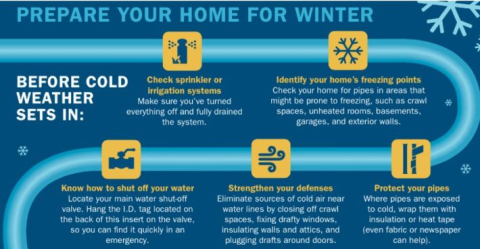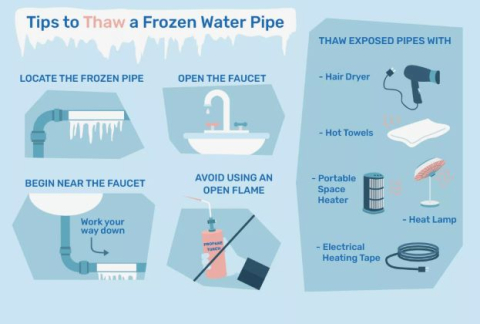
Tips for Frozen Water Pipes

It is always a good idea to check on your water pipes when Winter starts to set in. Water pipes in uninsulated areas like the basement or attic, or exposed pipes, can potentially freeze and burst. When water freezes in the pipes, the ice puts pressure on the inside of the tube and expands, which can lead to the pipe bursting or result in cracks in the pipe and, in some cases, even cause water damage or severe plumbing problems that can become expensive.

-
Monitoring water pipes for signs of freezing and acting accordingly can prevent pipe and water damage and cost less to repair if repairs are needed. Frozen pipes can block some or all the running water in your home.
Some signs that tell if your pipes are frozen are:
- Little to no water coming out of the faucets
- Frost on exposed pipes
- Sections of the wall, ceiling, or flooring are damp for no apparent reason
- Something frozen pipes can cause strange odours coming from the faucets or drains
There are several ways that you can help prevent your pipes from freezing. Here are a few tips that you can do while you’re ‘winterizing’ your home for the season:
- Insulate your pipes with pipe insulation
- Using heat tape or heat cables with a controllable thermostat
- Seal any cracks with caulk where the cold air may seep in, especially where the pipes are exposed
- Close outdoor faucets by the cut-off valve, and for added protection, use faucet covers for the winter months
- A small drip from your faucets can help keep the water flowing and prevent the pipes from freezing
- If you’re going away, ask a neighbour to check in on your home to ensure your pipes are intact
Frozen pipes can be challenging to locate because they are typically inside the walls. Depending on the structure of the home, some pipes can be exposed. For more problems finding pipes, check the water supply lines or use your hand to feel colder areas. You can also turn the heat up in the home to help thaw the difficult-to-reach pipes. Be sure to turn the faucet on because if only a few drops come out, you may have a frozen pipe.
If the pipes are in an accessible area, you may thaw the frozen pipe with a hairdryer or space heater while keeping the faucet turned on so that you can tell if it liquefies and the water flows freely. If the water flows, it can also help any excess ice in the pipe to melt. Never use an open flame to thaw a frozen water pipe.

If you have a frozen water pipe, you can always call a professional plumber if you cannot find the frozen pipe. If you have a pipe that burst, immediately turn off the main water supply in the home, turn the electricity off where the burst pipe is, and call a professional plumber.
By: Tricia Cook, Content Navigator